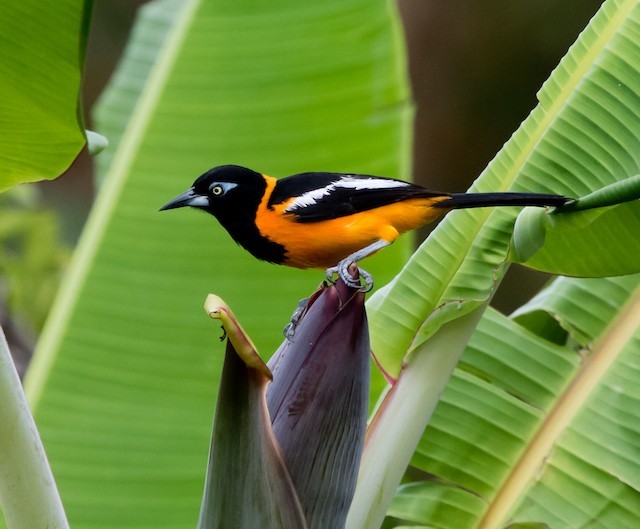Birdfinding.info ⇒ Common and easy to find across much of its range. In the West Indies, it is numerous and conspicuous on Aruba, Bonaire, and Curaçao. Also common in the lowlands of Puerto Rico, especially in the southwest, where it can usually be found at Guánica State Forest, La Parguera, and Cabo Rojo and Laguna Cartagena National Wildlife Refuges. In San Juan, it is fairly common in large gardens and parks, including Julio Enrique Monaga National Park.
Venezuelan Troupial
Icterus icterus
Northern Colombia, Venezuela, the ABC Islands, and Puerto Rico, where it occurs in scrub, brushland, dry forest, gallery forest, and woodland edges.
Adapts well to modified environments, living in plantations, parks, and gardens. Popular as a cagebird, which has led to the establishment of introduced populations outside its natural range.
The subspecies show somewhat different habitat preferences:
Ridgwayi is native to the coastal desert scrub and thorn forests of northernmost Colombia (Guajira), northwestern Venezuela, Aruba, Curaçao, Bonaire, and Isla Margarita. This race is also well established on Puerto Rico, where it was introduced during the colonial era. Records from other islands (St. Thomas, St. John, Antigua, Dominica, Grenada, and Trinidad), could represent either escaped cagebirds or vagrants, or some of both.
Icterus inhabits gallery forests and other semiopen and edge habitats of the Llanos from northeastern Colombia to the Orinoco Delta. An introduced population appears to be established in the intermontane valleys of Colombia from Bucaramanga to Bogotá, and may be spreading westward.
Metae appears to be confined to gallery forests along the Río Meta in the Llanos of northeastern Colombia; possibly also in adjacent Venezuela.
Identification
A large, vividly orange-and-black oriole with broad white patches on the wings. Has a black hood that extends to its upper breast, where it ends with a ragged border.
Striking facial features give it a formidable countenance: bold white irises framed by bare blue skin patches, and a pale blue triangle at the base of the bill.

Venezuelan Troupial, I. i. ridgwayi, showing characteristic ragged border on black hood. (Aruba; April 16, 2017.) © Steven Mlodinow

Venezuelan Troupial, I. i. ridgwayi. (Gotomeer, Bonaire; July 21, 2017.) © Carol Morgan

Venezuelan Troupial, I. i. ridgwayi, showing extent of black on back and orange on rump. (Cerro Saroche National Park, Lara, Venezuela; December 30, 2012.) © Eduardo Freitez Gassan

Venezuelan Troupial, I. i. icterus, showing black back and large orange rump. (Jardín Botánico José Celestino Mutis, Distrito Capital de Bogotá, Colombia; May 7, 2018.) © Drew Weber
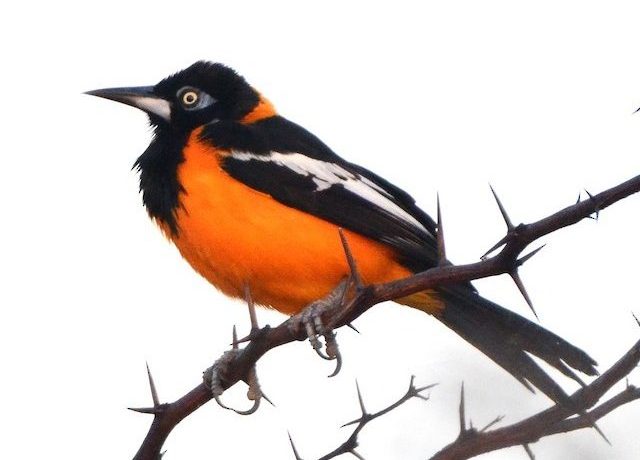
Venezuelan Troupial, I. i. ridgwayi. (Aruba; April 6, 2013.) © Steven Mlodinow

Venezuelan Troupial, I. i. ridgwayi. (Guánica State Forest, Puerto Rico; February 2, 2010.) © Steve Metz

Venezuelan Troupial, I. i. ridgwayi, showing black-and-white pattern on back and wings—also note black bar showing on left wing only. (Aruba; April 16, 2017.) © Steven Mlodinow
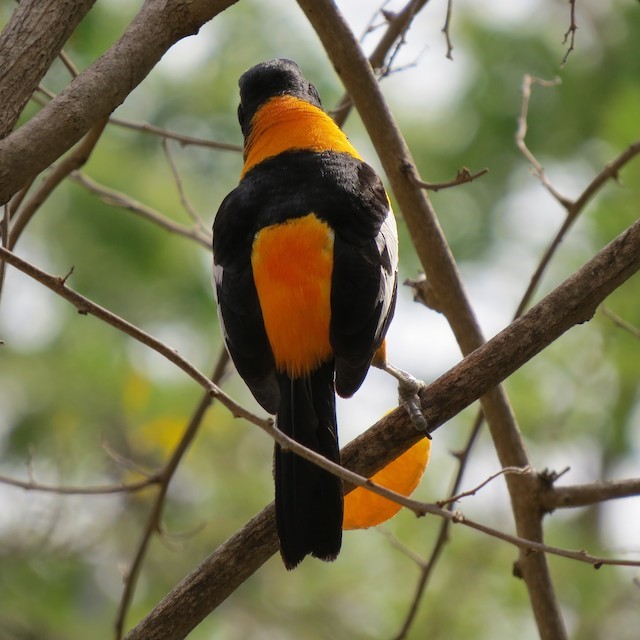
Venezuelan Troupial, I. i. ridgwayi, showing extent of black on back and orange on rump. (Flamingo Park, Curaçao; May 19, 2018.) © Tom Eck

Venezuelan Troupial, I. i. ridgwayi, showing orange wing linings. (Cabo Rojo National Wildlife Refuge, Puerto Rico; April 1, 2009.) © Ernesto Burgos
The extent of black on the head varies. Typically, ridgwayi has a full black hood, while icterus and metae have some orange on the back of the head, but there is variation within each subspecies.

Venezuelan Troupial, I. i. icterus, showing orange hindcrown. (Hato el Cedral, Apure, Venezuela; March 14, 2015.) © Margareta Wieser
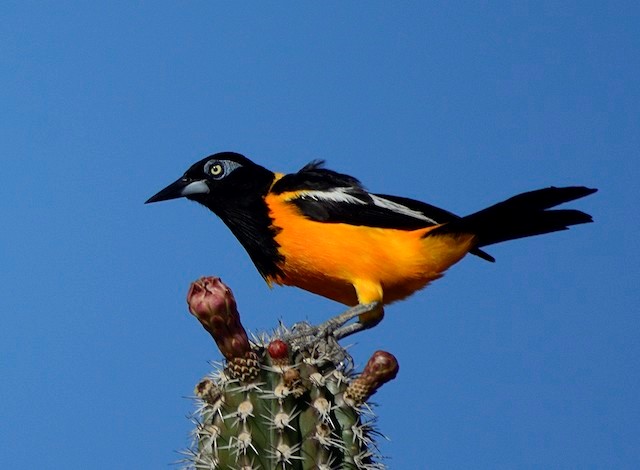
Venezuelan Troupial, I. i. ridgwayi, showing full black hood with ragged border. (Sasaki Pond, Aruba; April 20, 2017.) © Michael Tromp
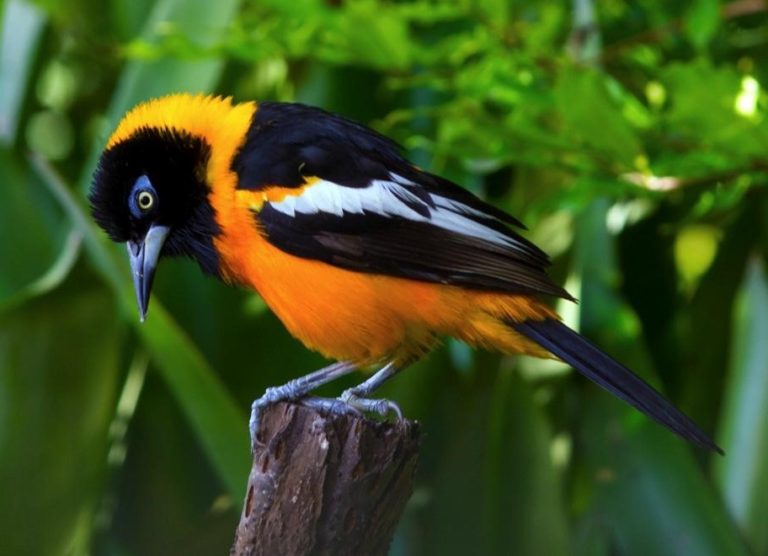
Venezuelan Troupial, I. i. icterus, showing orange hindcrown and a partial black bar across its white wing-patch. (Caracas, Venezuela; August 25, 2011.) © Miguel Emmanuelli
Metae has a black bar across its white wing-patch. The other subspecies sometimes show this feature, but not consistently.
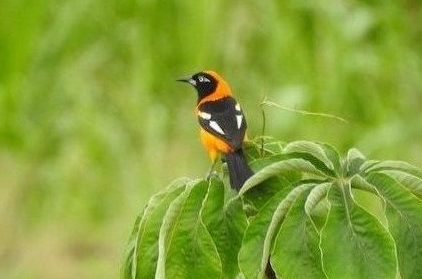
Venezuelan Troupial, I. i. metae, showing black bar on white wing-patches, and incomplete black hood with mostly orange crown. (Aricaporo, Casanare, Colombia; June 10, 2018.) © Felipe Estela
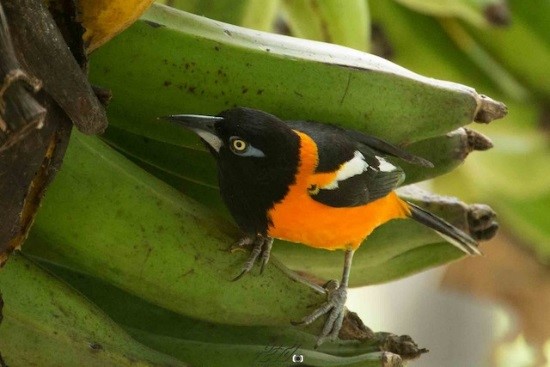
Venezuelan Troupial, I. i. metae, showing black bar on white wing-patch, and full black hood. (Finca Don Ruperto Garcia, Casanare, Colombia; July 22, 2017.) © Jorge Soto
Cf. Orange-backed Troupial. Venezuelan and Orange-backed Troupials are not known to overlap naturally, but the two could occur together, particularly in the region where Venezuela, Guyana and Brazil meet. Also, considering that both are kept as cagebirds, either could occur almost anywhere.
Venezuelan differs from Orange-backed in having a black back, more extensive black on the crown, larger white wing-patch, and larger blue skin patch behind the eye.
Notes
Polytypic species consisting of three recognized subspecies: icterus, metae, and ridgwayi. Formerly considered conspecific with Campo and Orange-backed Troupials, collectively known as the Troupial (Icterus icterus).
The national bird of Venezuela.
References
Ascanio, D., G.A. Rodriguez, and R. Restall. 2017. Birds of Venezuela. Christopher Helm, London.
eBird. 2019. eBird: An online database of bird distribution and abundance. Cornell Lab of Ornithology, Ithaca, N.Y. http://www.ebird.org. (Accessed May 18, 2019.)
Jaramillo, A., and P. Burke. 1999. New World Blackbirds: The Icterids. Princeton University Press, Princeton, N.J.
McMullan, M., and T. Donegan. 2014, Field Guide to the Birds of Colombia (Second Edition). Fundación Proaves de Colombia, Bogotá.
Meyer de Schauensee, R., and W.H. Phelps, Jr. 1978. A Guide to the Birds of Venezuela. Princeton University Press, Princeton, N.J.
Raffaele, H., J. Wiley, O. Garrido, A. Keith, and J. Raffaele. 1998. A Guide to the Birds of the West Indies. Princeton University Press, Princeton, N.J.
Ridgely, R.S., and G. Tudor. 1989. The Birds of South America, Volume I: The Oscine Passerines. University of Texas Press, Austin.
